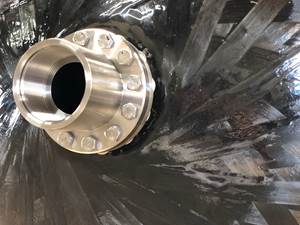Visionaries put composites in perspective
CAMX 2016 keynoters from Luminati Aerospace, Local Motors and Greg Lynn FORM outline their vision for the future of composites.
CAMX 2016 (Sept. 26-29, Anaheim, California) officially kicked off on Sept. 27 with a General Session that featured three creative and visionary keynote speakers who have applied composites in new and compelling ways that promise to change how we think about communication, transportation and architecture. About 1,700 show-goers filled the hall and heard testimony of composite’s high utility as a problem-solving material.
First up was Daniel Preston, CEO and CTO of Luminati Aerospace (Calverton, New York), a new company dedicated to bringing Internet connectivity to all areas of the world. He and his team are developing, among many products and technologies, high-altitude, long-endurance (HALE) unmanned vehicles that will harvest energy from wind and sun to stay aloft. These vehicles will be constructed of carbon fiber composites supplied by Hexcel using automated layup methods.
Due to a scheduling conflict, Preston could not attend CAMX in person, but did appear via video. He commented on his early success as a student (college at age 12, graduated in his teens) and in business (sold his first business and “retired” in his 20s), and how that led, eventually, to the HALE effort, which was prompted by a “large dot-com” seeking to provide Internet access for underserved regions around the world. The result is the V0-Substrata, a solar- and wind-powered, pilot-optional, composite aircraft that, Luminati hopes, will be doing HALE-based work soon.
Next up was Gregory Haye, general manager at Local Motors (Knoxville, Tennessee), who is overseeing his company’s development of vehicles built via advanced, large-format additive manufacturing methods and advanced materials, with a goal of reducing impact on the environment.
Haye walked the session through Local Motors’ “strive for less” mantra, which seeks to rethink how motor vehicle design and development paradigm. Or, as Haye put it, “The vehicle as we know it must die.” Haye emphasized Local Motors’ desire to condense the vehicle development process with digital-based tools that allow fast tooling and manufacturing, with both done via additive manufacturing technology provided by Cincinnati Inc.’s (Cincinnati, Ohio) Big Area Additive Manufacturing (BAAM) machine, which uses a chopped carbon fiber-reinforced ABS. Haye also discussed Local Motors’ work developing in just three months Olli, the multi-passenger, autonomous, composites-intensive mini-bus designed for urban mass-transit.
Wrapping up was Greg Lynn, owner of Greg Lynn FORM (Los Angeles, California), named one of the 10 most in influential architects living today, according to Forbes magazine. Lynn is at the forefront of creating fresh, functional and unusual designs and structures with composite materials.
Like Preston and Haye, Lynn is highly interested in building new paradigms based on the application of composites. In architecture, he noted, composites offer moldability and adaptability not possible with steel and aluminum. As a result, curved weight-bearing structures have become possible, bringing new dynamism to home and building design. The challenge, he said, is that many architects and designers are stuck in paradigm that relies on legacy materials, and they are trying to adapt to fit composites into that mindset. “If you think about composite beams like you think about steel beams, it’s a mistake,” he said, adding, “In fact, if you think about composite beams at all, you’re lost.” Lynn’s work, however, does not stop at building and construction. He’s also experimenting with composites in boat design and manufacture, and he is working with sports teams on innovative composite-based structures designed to help athletes better understand how their body performs in certain conditions, and help them recover from injury more quickly.
Related Content
McLaren develops aerospace-inspired ART method for volume composite super car engineering
Automated rapid tape (ART) technique, already deployed at the MCTC and to be used for future McLaren models, is capable of producing lighter, stiffer and stronger carbon fiber structures with less waste.
Read More“Structured air” TPS safeguards composite structures
Powered by an 85% air/15% pure polyimide aerogel, Blueshift’s novel material system protects structures during transient thermal events from -200°C to beyond 2400°C for rockets, battery boxes and more.
Read MoreInfinite Composites: Type V tanks for space, hydrogen, automotive and more
After a decade of proving its linerless, weight-saving composite tanks with NASA and more than 30 aerospace companies, this CryoSphere pioneer is scaling for growth in commercial space and sustainable transportation on Earth.
Read MoreBladder-assisted compression molding derivative produces complex, autoclave-quality automotive parts
HP Composites’ AirPower technology enables high-rate CFRP roof production with 50% energy savings for the Maserati MC20.
Read MoreRead Next
Cutting 100 pounds, certification time for the X-59 nose cone
Swift Engineering used HyperX software to remove 100 pounds from 38-foot graphite/epoxy cored nose cone for X-59 supersonic aircraft.
Read MoreCeramic matrix composites: Faster, cheaper, higher temperature
New players proliferate, increasing CMC materials and manufacturing capacity, novel processes and automation to meet demand for higher part volumes and performance.
Read MoreNext-gen fan blades: Hybrid twin RTM, printed sensors, laser shock disassembly
MORPHO project demonstrates blade with 20% faster RTM cure cycle, uses AI-based monitoring for improved maintenance/life cycle management and proves laser shock disassembly for recycling.
Read More












